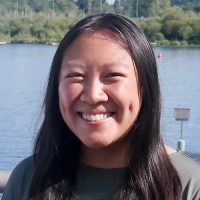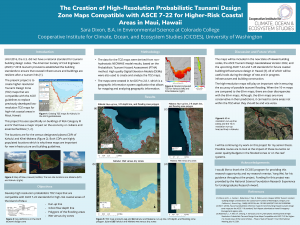
Sara Dixon
Colorado College
Research Mentor: Yong Wei
Project: The Creation of High-Resolution Probabilistic Tsunami Design Zone Maps for Coastal Hawaii
My name is Sara Dixon and I am a senior, environmental science major at Colorado College. This summer, I had the opportunity to work with Dr. Yong Wei on creating higher resolution Tsunami Design Zone (TDZ) maps that are compatible with ASCE 7-22 guidelines for higher risk coastal areas in Maui, Hawaii.
Until 2016, the U.S. did not have a national standard for tsunami building design codes. The American Society of Civil Engineers (ASCE) 7 2016 tsunami provisions established the building standards to ensure that coastal infrastructure and buildings are resilient after a tsunami hits. The present project is to create higher resolution TDZ maps that are compatible with the ASCE guidelines to replace previously developed low-resolution TDZ maps for high-risk coastal areas in Maui, Hawaii.
Specifically, I was tasked with creating TDZ for the census-designated places (CDP) of Kahului and Kihei-Makena. Both of these locations are highly populated which is why the maps I created are important for new infrastructure and building guidelines. Specifically buildings that have a major impact on the economy or civilians and essential facilities (categorized as Risk Category III and IV).
The data for the TDZ maps were derived from non-hydrostatic NEOWAVE model results that are based on the Probabilistic Tsunami Hazard Assessment (PTHA) method. High quality Digital Elevation Models (DEMs) were also used to create and analyze the TDZ maps. To create the maps, I used ArcGIS Pro 2.8.1 which is a geographic information system application that allows for mapping and analyzing geographic information.
The maps that I created this summer will play an important role in ensuring the accuracy of possible tsunami flooding. As the project continues, the full-time team will work to finish the entire island of Maui and the rest of Hawaii. The maps will be included in the new State of Hawaii building codes, the ASCE Tsunami Design Geodatabase Version 2022, and the upcoming ASCE 7-22 and 7-28 standards for future coastal building/infrastructure design in Hawaii. All of which will be useful tools during the design of new and in progress infrastructure and building construction.
I will be continuing my work on this project for my senior thesis. Possible routes are to look at the impact of these tsunamis on water quality/budgets or to see how many buildings are going to be impacted and in what way.
Although this internship was conducted remotely, I was still able to gain many professional and technical skills thanks to the CICOES program and my research mentor. We were also fortunate enough to be flown out to Seattle/UW campus for a week so we could do our final research presentations in person. It was a valuable experience because I was able to present my research to a wide range of people and meet all of the lovely interns that participated in the CICOES program this summer.
Finally, I would like to thank the CICOES program for providing this research opportunity and my research mentor, Yong Wei, for his guidance throughout the project.

